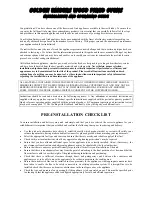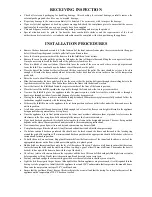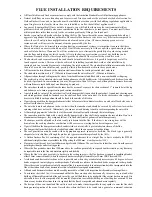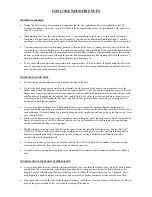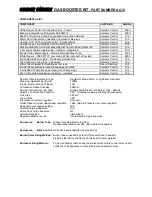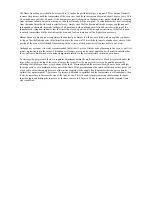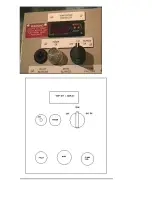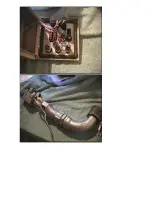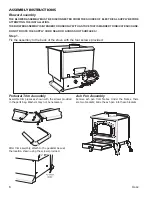
FLUE INSTALLATION REQUIREMENTS
•
All flues fitted to wood fired ovens must now comply with the Australian Standard for solid fuel burning appliances.
•
Natural draft flues are more than adequate for most wood fire ovens and are the preferred method of extraction for
Golden Embers Ovens and, in Australia, must be installed in accordance with the building regulations applicable to
open fire places in the locality where the oven is installed as well as the solid fuel appliance code.
•
In general, if a natural draft flue is not able to operate, you will find that there are other environmental airflow
problems which will probable also cause combustion in the fire chamber to be inadequate. You must rectify these
airflow problems rather than merely fix the extraction problem by fitting a fan forced unit.
•
Smoke is generally only produced when lighting the fire. The fumes thereafter are not unpleasant and should not
aggravate neighbours or statutory authorities. Because Golden Embers ovens use so very little timber compared to
others, they will only produce negligible amounts of smoke at any time. Of course, burning green or wet or
resinous woods will increase the amount of smoke generated by the fire.
•
Where the fluing is to be directed into existing ducting or communal systems, it is important to ensure that these
ducts do not have an excessive build up of fat. It will also be necessary to fit the oven with a spark-arresting device,
such as
Golden Embers Flame and Soot Filter
modules so as to eliminate the possibility of sparks being carried
into the flues and igniting any fatty deposits. A fire in the ducting or extraction system of any building can be
disastrous. Because of this, wherever possible, provide a dedicated flue system for the wood fire oven.
•
The ductwork can become extremely hot and should be insulated wherever it is possible for patrons or staff to
touch exposed sections. This can either be achieved by installing insulated duct-work or after installation by
coating ducts in a vermiculite cement or insulating fire rated material. The standard installation recommended is for
the use of a vented twin skin flue, and, possibly a third (often-decorative) skin in the exposed areas
.
•
All flues must be twin skinned, with a stainless steel inner skin and a vented galvanised steel outer skin.
•
The standard inner skin used is 8” (205mm) in diameter and the outer skin is 10” (254mm) in diameter.
•
All penetrations through ceilings must be clear of combustible material and fitted with a non-combustible ceiling ring.
•
The preferred cowl is a stainless steel wood fired appliance cowl with draft diverter. A directional wood fired cowl can also
be used, if preferred. In some instances you may be required to fit an AGA gas cowl, although these decrease draw and
will result in more rapid build up of wood burning by-products.
•
The outer duct should be spaced from the inner duct by means of z spacers (or short sections of 1” square tube) at the top
and bottom so as to ensure proper venting and continuous airflow.
•
A notch should be cut out of the outer duct to allow the damper shaft to penetrate the outer duct. A quadrant, showing open
and closed positions should be fastened over the shaft and fixed to the outer duct. If a third or decorative skin (copper or
brass etc) is fitted then the quadrant should be fixed to the outside of this skin.
•
If gas is being used then the damper blade must either be 5mm smaller in diameter or have a notch cut off each side so as to
never allow the duct to be sealed.
•
The outer duct must end about an inch or so lower than the inner duct and should be covered by a skirt cowl or weather
spinning which does not seal it. Alternatively you can use a wood burning twin skin cowl incorporating the outer skirt.
•
A 10mm high gap must be left at the foot of the second skin to allow airflow through the inter-skin gap.
•
The inner skin must be fitted with a steel butterfly damper with a long shaft that penetrates the second skin. Don’t use
aluminium cast dampers – they warp and fall out. Use fixed shaft steel or galvanised metal dampers only.
•
The damper must be adjusted so that air is only just drawn into the flue. If the draw is too strong, heat will be
drawn from the cooking chamber combustion will be excessive, wasting fuel and creating more soot.
•
If gas is fitted then the damper must either be undersized or have cut-offs to prevent absolute closure of the flue.
•
The damper shaft must be fitted with a lockable quadrant which shows open and closed positions.
•
The roof penetration must be sealed with an appropriate approved aquaseal or deck-tite. The black type is generally
adequate for twin skin flues, although the pink or red types are sometimes preferred by the AGA.
•
A Golden Embers flue kit, containing all of the required elements for a straight flue to 4m is available for $325.00
additional straight sections are available for $50 per length of 900mm.
(As at September 1998)
•
Flues must clear the roof by at least 600mm and preferably 1200mm. The cowl must be at least 4m away from the nearest
point higher than the outlet venting point.
•
Where the flue protrudes more than 1200mm above the roofline, particularly in exposed weather situations, stay lines may
be required to secure the flue and maintain rigidity and stability.
•
Where the flue is in close proximity to timbers in the ceiling space etc, the flue has been wrapped in insulating blanket,
either 25mm ceramic blanket (where the exposed timbers are highly flammable) or 50mm CSR Fibretex R350.
•
Avoid bends and horizontal sections as far as possible and where they are absolutely necessary use 45 degree or lesser
bends as opposed to ninety degree or sharper bends. Preferably use radius or lobster back bends as opposed to sharp bends.
Where there is any significant extent of horizontal flue it is recommended that an inspection hatch be incorporated into the
flue at the start ane end of any horizontal section to facilitate cleaning and maintenance.
•
All bends and horizontal sections must be readily removable or fitted with inspection hatches and/or cleaning elbows.
•
To minimise the risk of fire, it is recommended that the flues are cleaned at least annually, to remove any soot and other
build up of flammable materials, although, in reality, you will find these to be negligible if the correct timbers are used. It is
advisable to have the flue inspected after six months of operation to establish what degree of build up has occurred. Where
there are any horizontal sections then it is required that the flues be inspected and cleaned more regularly.
•
The design of the oven, tunnel and flue outlet is such as to make it near impossible for any sparks to enter the flue shaft
during normal operation of the ovens. Nevertheless, where the flue is to be vented into a general or communal extraction
Summary of Contents for Wood Fired Ovens
Page 14: ...GOLDEN EMBERS AC11 CLASS 1 GAS WOOD FIRE GAS TRAIN SCHEMATIC AND LEGEND ...
Page 17: ......
Page 18: ......

